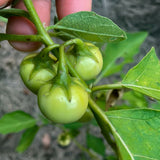Liberian Kittley (Pea Eggplant)
Solanum torvum
Please note: this listing is for SEEDS, not fresh eggplants!
These fruits are a lighter color, very bitter, very productive, easier to pick, and are especially small - sometimes the size of a pea!
Katilee Eggplant is very important in West Africa, and many other tropical parts of the globe. Our seeds were grown by Liberian farmers in Buffalo, New York for their own community and business. You can eat these small, round, and bitter eggplants when green and unripe. Katilee can also be boiled before eating or made into a sauce. This Katilee is used as medicine to treat high blood pressure, asthmas, diabetes, fever, or malaria.
Also known as Kittley, Katilee, Kiterley, Kitilly.
Days to maturity: 90
Seeds per pack: 75-80
Germination rate: 97% on 01/24/2025
Planting / harvesting notes
These are heat-loving, and seeds should be started indoors about 1/8-1/4" deep, about 8 weeks before the last frost. Transplant into the garden well after the danger of frost. The growing characteristics are similar to most eggplants. The plants can reach about 4-5 feet tall and should be planted 18 inches apart. They need full sun and fertile soil. Staking is recommended for these plants. The eggplants begin green, but should be picked when they are about pea-sized and green. They must be picked regularly to keep production and ensure they don’t over ripen. For seed saving the fruits ripen to orange.
Seed keeping notes
Eggplants are generally self-pollinating, though we isolate different varieties of the same species by at least 300 feet, in hopes that flying insects will not cross pollinate them unexpectedly. Eggplant seeds are darkened when the fruits get far past their edible stage, and fruits have turned another color, in this case yellow, orange or red. Cut the fruit, scrape out seeds into a vessel, add a little water and allow the seeds to settle. Pour off the floating materials and then strain the seeds through a strainer and allow them to dry in heat or shaded sunlight. Lay out the seed to dry on a screen or paper tower in a heated area like the greenhouse or right in the kitchen cabinet over the stove.









